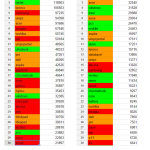As part of an effort to refresh UMPCPortal and bring it up to 2015 SEO standards I’ve been taking advice from various experts and looking closely at the quality of my site. Google Webmaster Tools has been instrumental to the process.
I’m currently doing two things:
1) Removing very old and very short content.
2) Optimising my keyword landscape.
UMPCPortal is over 9 years old and in 2014 had around 50000 pages listed in Google based on around 5500 articles, 1000 product pages, about 100 special pages and 20000 gallery images. The latter, I found out in early 2015, was screwing up my keyword spread, had very little textual content, was ad-heavy and clearly dragging down the site. The keyword spread was heavily biased towards manufacturers and brands which, as a niche technology site (ultramobile pc technology news, research, reviews) should not be my focus.
You can find your keyword spread in Google Webmaster tools under ‘Content Keywords’ in the Google Index section.
After removing about 2000 articles from search indexes (I moved them to a new WordPress category called ‘history’ and wrote some php in the theme header that would check for that category and add NOINDEX, NOFOLLOW if it found it.) I started working on the gallery. I manually blocked about 200 photo albums and, using the webmaster tools keywords list, started to track the movement of keywords. The process is still happening as Google works its way through the site but take a look at the before and after results so far.

In October last year I had over 127000 occurrences of the word asus. Today, that’s down to 29000. My important and evergreen keywords that appear in articles but never in the gallery have now had a chance to rise. My focus keywords are now appearing in the top 30 and the old (sometimes completely irrelevant and out-of-date) keywords are dropping away.
Tablets, Windows, mobile, PCs, review, news, intel, core, atom and battery keywords represent my focus way, way batter than galaxy, sony, images, tab, eee and archos do.
The process continues (based on what I’ve seen so far it can take months for this list to settle after a site has been changed) and while I have reduced my index from 50000 down to 24000 I am targeting 10000 indexes [“The total number of URLs from your site that have been added to Google’s index.”] When the gallery has been completely de-indexed I’ll start to look at weeding-out short, unimportant articles from 3-5 years ago, consider removing some or all WordPress tag pages and re-visit the keyword spread to see if it is focused enough. I have new keyword sets (mini pc, hdmi stick, miracast, wirefree, 8-inch, touchscreen, detachable, 2in1, ultralight, ultramobile, skylake, etc.) that I want to see in the top 30 by the end of 2015 but that’s a longer-term project of focusing my new content around these keywords.

At the end of August I will be looking closely at my ‘position’ using the searcth analytics feature. While my position varies between 11 and 14 right now I can’t take much notice of it as the keyword spread is updating. When that settles down then it becomes important to measure how effective you are within this keyword landscape by monitoring the position (available under Search Analytics in your Search Console. Image above.) What I’m hoping and what I believe will happen is that because my top keywords will have good articles behind them (and not simple image pages) that the keywords will be better positioned. I’m hoping for a minimum average of position 10 and my target is position 6. I’ll be happy to see position 8 by September though and that’s based on some other, more nimble, more recent sites I have that don’t have a gallery component. Check back later in the year to see if I made it!
I may be wrong but I’m trying to think like Google. A focused keyword-landscape has to be the first step to positioning a site for the correct search engine positioning.
P.S. I was surprised to see ‘says’ and ‘it’s’ in the list and I need to take a closer look at why I use the rather unfocused word ‘device.’












Thank you very much @Steve.